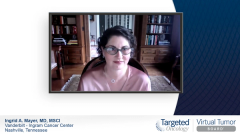
Case 2: Treatment Options at Recurrence of HER2+ Breast Cancer After 5 Years
The panel of experts in breast cancer discuss treatment options when the cancer has metastasized.
Episodes in this series

Ingrid A. Mayer, MD, MSCI: Five years after initiating adjuvant treatment, she now has symptoms. But either way, her imaging showed 3 liver lesions. The largest 1 is pretty big, 6.2 cm, and the biopsy confirms that her cancer is still triple positive. She has ER [estrogen receptor]–positive and HER2 [human epidermal growth factor receptor 2]–positive disease. Her performance status is fantastic.
Sara Tolaney, MD, MPH: We have a patient who unfortunately has metastatic, ER+, HER2+ breast cancer, and we’re trying to think about how to approach this patient in the first-line metastatic setting. Andy, we turn to you. How would you think about a treatment choice in this case?
Andrew Seidman, MD: If I understand this case correctly, 5 years after adjuvant therapy, does that mean she was actually on her AI [aromatase inhibitor] when she relapsed?
Sara Tolaney, MD, MPH: Yes, we’ll say she was on her adjuvant AI at the time of disease recurrence.
Ingrid A. Mayer, MD, MSCI: Five years into it, so secondary endocrine resistance, technically. Right?
Andrew Seidman, MD: Yes, and we know this is ER+ and HER2+ disease. If you presented this case a little differently, if it was bone only and not liver, 1 of the things I always want to do is target the targets. I would have been inclined to swap out my AI for fulvestrant, for example, resume HER2 therapy, and maybe add another agent, which I’ll let the rest of you talk about. But in this scenario, I’m more inclined to address this case because of liver metastasis as a CLEOPATRA-type patient, and probably use weekly paclitaxel with trastuzumab and pertuzumab as my first-line therapy. And then be confident in getting rid of taxane after a maximum of about 6 months, depending upon the response.
Ingrid A. Mayer, MD, MSCI: I agree with you, and I’ll do exactly what you said, but there’s 1 thing that I’m curious how people feel about. Granted, she has 5 years in there. But I haven’t seen a lot of patients recur after pertuzumab in the neoadjuvant or adjuvant setting. Clearly, when the CLEOPATRA study was performed, nobody had pertuzumab. And a good proportion had trastuzumab. Obviously that study looks amazing. In the real world, it still looks good but not amazing. I’m curious, with these newer drugs coming out, if the dogma of using CLEOPATRA is the same, because I hate recycling drugs.
Andrew Seidman, MD: I always teach my fellows that resistance is dynamic, not static, so you can go back, and the longer your exposure to your leftovers, to the meal you had yesterday, the better the chance of benefit. But if this case were presented and it was a year, a year and a half, then I’d be thinking about an ADC [antibody-drug conjugate].
Ingrid A. Mayer, MD, MSCI: A year into it, this is clearly as if it was metastatic disease from the get-go. That was first line. Whatever she had in the adjuvant or neoadjuvant setting was first line. But even this case is a little farther out. I still wonder, is it going to be the same response? Should we use the same chemotherapy? The same agents? I don’t think it’s wrong, They see proportional response as further analysis has shown. Obviously the response is not going to be as good as we perceive them to be. It’s a lot less short-lived. Let’s put it that way.
Transcript edited for clarity.














































